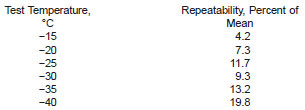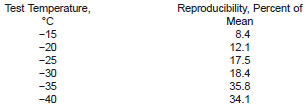ASTM D4684 standard test method for determination of yield stress and apparent viscosity of engine oils at low temperature
11. Report
11.1 Apparent Viscosity and Yield Stress - For unused oils, report the final test temperature and either the apparent viscosity or the existence of yield stress, but not both. For used oils, report both apparent viscosity and yield stress.
11.2 Yield Stress - Report as less than the value at which rotation was observed.
11.3 Apparent Viscosity - Report as follows:
11.3.1 If the apparent viscosity is less than 5000 mPa•s (cP), then report the apparent viscosity as less than 5000 mPa•s (cP).
11.3.2 If the apparent viscosity is between 5000 and 100 000 mPa•s (cP), then report the apparent viscosity to the nearest 100 mPa•s (cP).
11.3.3 If the apparent viscosity is between 100 000 and 400 000 mPa•s (cP), then report the apparent viscosity to the nearest 1000 mPa•s (cP).
11.3.4 If the apparent viscosity is greater than 400 000 mPa•s (cP), then the apparent viscosity should be reported as greater than 400 000 mPa•s (cP).
11.3.5 When employing software that provides three viscosity values, the first value shall be reported as the apparent viscosity by Test Method D4684. If desired, report all three values, taking care to also report the sequence of the values. Never report a value that is the average of the three measured values.
12. Precision and Bias
12.1 Precision (Unused Oils) - The precision of this test method as determined by the statistical examination of interlaboratory test results is as follows:
12.1.1 Yield Stress - In the case of pass-fail data, no generally accepted method for determining precision is currently available.
12.1.2 Apparent Viscosity:
12.1.2.1 Repeatability - The difference between successive results obtained by the same operator with the same apparatus under constant operating conditions on identical test material would, in the long run, in the normal and correct operation of the test method, exceed the following values only in 1 case in 20. The repeatability as a percent of the mean apparent viscosity is shown as follows:

12.1.2.2 Reproducibility - The difference between two single and independent results obtained by different operators working in different laboratories on identical test material would, in the long run, exceed the following values only in 1 case in 20. The reproducibility as a percent of the mean apparent viscosity is shown as follows:

12.1.3 The interlaboratory program included nine test oils at the -15°C test temperature with eleven laboratories participating. Nine test oils were included at the -20°C test temperature with eleven laboratories participating. The -25°C test temperature included 18 test oils with 14 laboratories participating. Nine test oils were evaluated at -30°C in 13 laboratories. At the -35 and -40°C test temperatures, six test oils were evaluated in twelve laboratories.
12.2 Precision (Used Diesel Engine Oils) - The precision of this test method as determined by the statistical examination of interlaboratory test results is as follows:
12.2.1 Yield Stress:
12.2.1.1 Repeatability - The difference between successive results obtained by the same operator with the same apparatus under constant operating conditions on identical test material would, in the long run, in the normal and correct operation of the test method, exceed the following values only in 1 case in 20:

NOTE 4 - When no yield stress is detected (movement with 10 g weight), X = 0.
12.2.1.2 Reproducibility - The difference between two single and independent results obtained by different operators working in different laboratories on identical test material would, in the long run, exceed the following values only in 1 case in 20.

12.2.2 Apparent Viscosity:
12.2.2.1 Repeatability - The difference between successive results obtained by the same operator with the same apparatus under constant operating conditions on identical test material would, in the long run, in the normal and correct operation of the test method, exceed the following values only in 1 case in 20. The repeatability as a percent of the mean apparent viscosity is shown as follows:

12.2.2.2 Reproducibility - The difference between two single and independent results obtained by different operators working in different laboratories on identical test material would, in the long run, exceed the following values only in 1 case in 20. The reproducibility as a percent of the mean apparent viscosity is shown as follows:

12.2.3 The interlaboratory program included nine laboratories and nine test oils at the -20 and -25°C test temperatures. The used oils included end-of-test drain samples from Mack T8, Mack T8E, Cummins M11-EGR and Mack T10 engine tests, with soot loadings (as measured by thermogravimetric analysis) ranging from approximately 5 to 9 % (see RR: D02–1517).
12.3 Bias - Since there is no accepted reference material suitable for determining the bias for this test method, no statement on bias is being made.
13. Keywords
13.1 low temperature flow properties; low temperature viscosity; mini-rotary viscometer; pumping viscosity; used diesel engine oil; viscosity; yield stress



